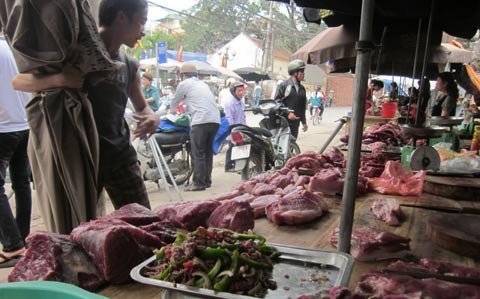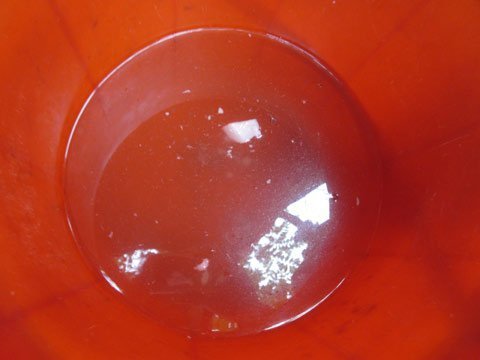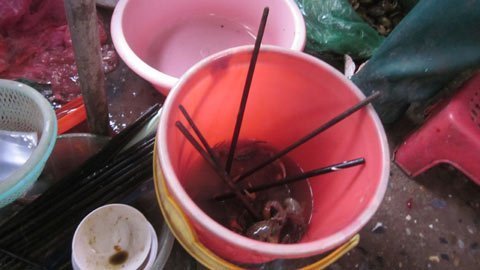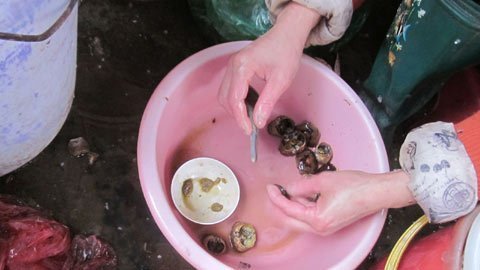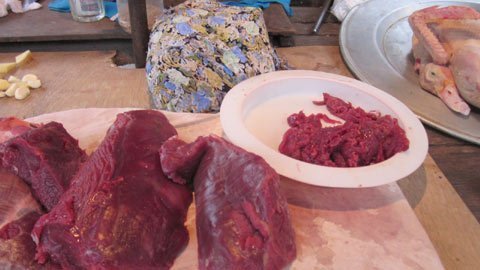
Là được trích từ tờ rơi (truyền đơn) này:

của Quân đội Mỹ có từ năm 1966-1967 sau khi Anh hùng liệt sĩ Nguyễn Văn bé bị bắt và chiêu hồi.
--------------------------------------------------------------------------------------
Source: http://www.psywarrior.com/BeNguyen.html
The Strange Case of the Vietnamese
"Late Hero" Nguyen Van Be
SGM Herbert A. Friedman (Ret.)

One of the most unusual psychological campaigns of the Vietnam War concerned the martyred hero Nguyen Van Be. According to the legend, the young Viet Cong guerrilla was on a mission with his comrades on 30 May 1966 transporting explosives when they were attacked and Be was captured. Rather than submit, he chose to sacrifice himself and died a martyr’s death. The American and Vietnamese troops demanded that he instruct them on the workings of an unknown explosive mine. Be did so. He picked up the mine high over his head, and shouted, "Long live the National Front for Liberation. Down with American Imperialists." He then smashed the mine against an armored vehicle, killing himself and 69 American and Vietnamese officers and soldiers.
For six months, the Lao Dong (Communist) Party told of his heroics in prose and song. Young men were urged to emulate the fallen hero. Be had been a model guerrilla. He had joined the People’s Youth League at an early age and later became a volunteer in the Liberation Army. There were poems, booklets, plays and radio broadcasts telling of Be’s death and sacrifice. The communists in the North even wrote an opera for Be. In addition, two statues were erected in his honor. The Viet Cong awarded him the posthumous title of "Indomitable Loyalty and Magnificent Bravery."
The detailed story appeared in the Hanoi newspaper Phu Loi of 30 May 1966:
...[Nguyen Van Be with] two cells of the transport unit were assigned with the mission to convey arms and ammunitions to the front. As they were approaching the Beo Canal of My An village, My An District in Kien-Giang Province, they were encircled by a convoy of 49 enemy armored cars.
Following a fierce fighting with the enemy, Nguyen Van Be was captured by them. Afterwards. He was subjected to the most savage torture, and yet they were unable to get anything from him. Finally, they took him along with the captured arms to My An District where they resumed the torture and forced him to explain the handling of various sorts of mines, which he had transported. Be pretended to comply with the order and set about a demonstration session. Suddenly, he seized a mine weighing 10 kilos and shouted: 'Long Live the National Liberation Front of South Vietnam, down with the American Imperialists.' As he stated these words, he rushed like a thunderbolt at the nearest M-118 tank and banged the mine against it.
The explosion set off by the 10 kilos mine triggered a series of explosions as the pile of mines captured by the enemy were ignited and went off. By this act of heroism, Nguyen Van Be sacrificed himself but he had destroyed a M-118 tank and heavily damaged two M-113 tanks, killed and wounded 64 enemies, among them 12 Americans.Time Magazine of 17 March 1967 told the world of the Communist hero:
The greatest Communist folk hero to emerge from the Viet Nam war is a skinny teen-ager named Nguyen Van Be, who left his home in the Mekong Delta to join the Viet Cong. Van Be’s death is recorded in poem, song and story throughout North Viet Nam and among the Viet Cong. Prompted by Hanoi's radio and newspapers, North Vietnamese schoolchildren compare his deeds to “a thousand thunderbolts.” His picture, taken when he was a guerrilla, has become a pinup among the Viet Cong, who name squads after him and hold periods of silent meditation to gain strength from his example. The Viet Cong have awarded him a posthumous decoration for “indomitable loyalty resoluteness and sublime bravery,” and declared that he “has shaken an entire region of the country and terrorized the enemies.” Earlier this year, his deeds were celebrated at a gathering in Hanoi of an organization called, in the best Communist fashion, "The Anti-U.S. National Salvation Heroes and Emulation Combatants Congress."
Just what were the deeds that have made Nguyen Van Be such a hero? As the Communists tell it, he was crossing a canal in the upper delta one day last May in a sampan, together with eleven Viet Cong companions and a heavy load of ammunition, when the sampan was attacked by a squadron of U.S. and South Vietnamese amphibious armored carriers. Nguyen Van Be fought off the attackers for 30 minutes with his rifle and was taken prisoner, “covered with mud and blood,” only when his ammunition was gone and his companions were all dead. Pretending cooperation with his captors, he then managed to pick up a 20-lb. Claymore mine. Raising it over his head, he valiantly shouted, "Long live the National Liberation Front!" and dashed it against the armored carrier, killing 69 U.S. and South Vietnamese troops as well as himself.
All this exploded in their face in February 1967. Nguyen Van Be was found alive and well in a Vietnamese prison camp. Be agreed to cooperate with the Government of Vietnam (GVN) and told the true story of his capture in a 13 March 1967 interview. He said that the battle lasted just a few minutes and he had never fired a shot. Instead, he dove into a canal in an attempt to escape, but was captured when a Vietnamese soldier grabbed him by the hair.Nguyen Van Be reads about his alleged
exploits in the Liberation Army Newspaper
Time said:
Surrounded by the armored carriers, the overloaded sampan had immediately begun to list and overturned into the water. When one of their number had been killed, the Viet Cong squad jumped out of the sampan and fled to shore. Be also leaped into the water and was trying to hide himself under the surface when a South Vietnamese soldier grabbed him by the hair and pulled him out. He was the only one taken captive—and he had never got to fire a single shot.
The opportunity to show that the enemy has brazenly lied seldom occurs in psychological operations. The Government of Vietnam and the Joint United States Public Affairs Office (JUSPAO) took full opportunity of the chance to strike at the communists, embarrass them, and destroy their credibility. According to Robert W. Chandler, War of Ideas – The U.S. Propaganda Campaign in Vietnam, A Westview Special Study, Boulder, CO, 1981, "By July 1967 JUSPAO had publicized the Be affair for Southern audiences through the production of more than thirty million leaflets, seven million cartoon leaflets, 465,000 posters, a special newspaper in 175,000 copies, 167,000 photographs, 10,000 song sheets, several motion pictures, and numerous radio and television programs featuring Be, his family, and his Hoi Chanh (Viet Cong who had returned to the GVN) friends."
The Time Magazine article ended with this comment:
This week the U.S. psychological-warfare team—to which Nguyen Van Be is indeed a hero—will begin distributing some 7,000,000 leaflets and 100,000 posters in both South and North Viet Nam showing Nguyen Van Be posing beside Communist newspapers headlining his fictitious martyrdom. More than one-third of the leaflets will be dropped over North Viet Nam, where the government recently erected a statue in downtown Hanoi showing Comrade Be holding his mine overhead at the precious instant of immortality.
The Truth about Nguyen Van Be Song SheetThis is the propaganda song meant to debunk the myth and legend of Nguyen Van Be. The music by Nguyen Van Long and the lyric by Nguyen Cong Luong. The literal title can be translated as “The effervescent truth about VC Heroes and the Hero Nguyen Van Be.” Some of the text is:
Illustrated in Van Tac Vu Magazine, Issue No. 11.
They know no better,Thomas William Hoffer mentioned Nguyen Van Be in an article entitled "Nguyen Van Be as Propaganda Hero of the North and South Vietnamese Governments," published in The Southern Speech Communication Journal, Volume 40, 1974. He says:
I'm still here
But the rumor was spread that I have died.
And with many embellishments to my life they added…
For the purpose of propaganda.
A tabloid newspaper with the hero's name was produced and distributed nationwide. Culture-drama teams, groups of Vietnamese singers and dramatists touring the villages, carried with them 10,000 song sheets espousing 'The truth about Nguyen Van be.' Numerous radio programs featuring Be, his family, and three other defectors were broadcast over VTVN, the Vietnamese government owned and operated network. Plans were laid for a weekly five-minute radio report by Be, reporting his experiences, along with commentary on Vietnamese developments and reactions from the presses of other countries not directly involved in the conflict.
Among many leaflets printed, one featured Be's mother, with the caption, "I Ought to Know My Own Son." Be's three defector friends were captioned 'We Knew Too Much' in their leaflet testimonials. Special portable exhibits including photo-panels were produced for display at the provincial and district level. Loudspeaker tape recordings were produced for use on airborne helicopters hovering over the Vietnamese countryside.Speaking of Nguyen Van Be’s family, Monta L. Osborne was the Chief of Field Development Division in the Joint United States Public Affairs Office (JUSPAO) in Saigon in charge of the Chieu Hoi (Open Arms) program during the Vietnam War. His letters home tell of meeting the Be family:
Nguyen Van Be was perhaps our prize capture of the war. He had been played up by the North Vietnamese regime as one of the great heroes of the war and all of the young men of North Vietnam had been exhorted to emulate his heroism. Hanoi reported that he had been captured, but even during capture had blown up a U.S. tank before he was killed. As it developed, Nguyen Van Be had been captured and our people found him in a Government of Vietnam prisoner-of-war camp. We managed to extract him from the camp, used him as the author of many leaflets which we dropped over North Vietnam and the North Vietnamese forces in South Vietnam. In this output he discredited all that Hanoi had said about him. We arranged for him to meet the press and to appear on radio and TV.
One of my assistants, Don Rochlen, found that Nguyen Van Be’s family (father, mother, brothers and sisters) were living in an area where they could be captured by the Viet Cong, in retaliation for Be’s anti-Hanoi propaganda. Don proposed that he visit the contested area in which they were living, and with the help of a U.S. Army company enter the area and remove the family from their danger. We were able to gain approval for this project. Don did manage to move the family from the dangerous area, placed them on a plane, and traveled with them to Saigon. On that evening I heard a station wagon drive up to my villa. There was Don, with the entire family. He reported that the arrangements he had made with the GVN officials to receive the Be family had fallen through. I offered to keep the family overnight, but insisted that they be moved the next day, since I was due to leave for Bangkok and then go, with my family on home leave. Here I was, with a family that was undoubtedly an important target for the Viet Cong, in my own domicile. I managed to bed them down, stayed up all night, and made several tours of the neighborhood to see whether there were any suspicious characters hanging around. The next morning I fed them (the father, mother and four children) on bacon and eggs. Don did manage, during the day, to get them removed to a safe haven.
The Communists retaliated. They simply ignored the Allied propaganda or claimed that it was all an American fabrication. Even though he was clearly alive, they celebrated the anniversary of his death. They continued to write newspaper articles, make films, erected a third statue and published another biography of his life. They simply ignored the fact that he was alive and continued telling their lie repeatedly, believing that if it were told often enough, the people would believe.
Communist Poster honoring Nguyen Van Be’s heroic actionRadio Hanoi attacked the disclosure that Nguyen Van Be was still alive in a program aired 16 March 1967. The title of the commentary was, "A Dirty Psychological Warfare Trick."
During the last few days, the psychological warfare organs of the Americans and their lackeys in Saigon employed every propaganda trick to invent a story of the appearance of Nguyen Van Be in their prison before they released the news that Nguyen Van Be had been arrested and is living safe in their claws, without being tortured. The Thieu-Ky clique's psychological warfare minister held a press conference during which a Nguyen Van Be appeared before journalists, who questioned him.
There is nothing new in this sensational farce. Any conjuring trick of the Americans and their lackeys is only a repetition of the ridiculous comedy they played when they invented the story of Tran Van Van's assassin, one-eyed man who professed to be a Viet Cong.
Taking this experience into account, this time they picked out an intact, good-looking man. They also taught him what to say. They plotted to use time to blur the hero's image so that they could easily deceive the public. But 10 months have not lessened the noise of the Nguyen Van Be bomb, but made it resound more.
Brother Be's image has been carved increasingly deeply into the hearts of millions of people. It is necessary to warn that their trick about hero Nguyen Van Be is an insolent offense to all the Vietnamese people. They dared offend an outstanding anti-US national salvation generation. Southern compatriots, south youths, and especially, liberation combatants, comrades of Hero Nguyen Van Be, will surely not forgive them. We will punish them severely.
The Lao Dong’s (Communist Party) newspaper Nhan Dan went so far as to claim, "It is not necessary to look for Be’s replacement in the bulky documents and files of the CIA. Zorthian (Director of JUSPAO) merely resorted to the Hollywood technique of selecting actors and the medical art of changing facial traits as applied in Hong Kong and Japan."
On 25 May 1967, the Hanoi newspaper Tien Phong published a song by Huy Du honoring Be. Some of the lyrics are:
Along the shore of the Mekong River, there rose a hero, just 20 he was.On 28 May 1967, the Hanoi newspaper Tien Phong honored the first anniversary of Nguyen Van Be’s heroic actions:
Full of promise like spring coming to the countryside.
How glorious he is, this Nguyen Van Be.
His gentle countryside has become more beautiful because of him.
In preparation for the new program entitled “Follow the examples of Nguyen Van Be and Nguyen Viet Xuan; improve the revolutionary spirit of attack; and resolutely carry out the counsels of Uncle Ho” on the occasion of the first anniversary of hero Nguyen Van Be, the Central Group has coordinated with the Association of Musicians to emphasize the importance of promoting the writing of new songs using the subject of hero Nguyen Van Be.The paper goes on to say that a musical play entitled “Three times a Hero” has been written, also a short play entitled “The Hero of Rach Gam” and a group of comedians had created a comedy show about Be. Two paintings of Be had been done by Vietnamese artists and they were in the process of producing an agitation propaganda poster. Two large statues of Be were being carved at the time of publication. 300,000 copies of the biography of Be were ready for sale. Finally, a number of short films and poems in his honor had been written.
Another article in the same newspaper was entitled “Nguyen Van Be lives forever in my Heart.” In this article a soldier named Do Yen attached to a signal unit tells of wanting to volunteer to join a combat unit after reading of Be’s exploits. His comrades tell him that every job is important and he must follow the orders of his commissars just as Be had done. He ends:
The example of Comrade Be has helped me to see the truth of his glorious life. In know now that in the future, whatever task assigned me by the Party and the people and whatever the problems or risks, I’ll fulfill that task in an outstanding way. It is because comrade Be is with me and will live forever deep in my heart.In June 1967, U.S. Intelligence wrote a document reporting on the Communist media coverage of Nguyen Van Be. It stated that the Allied expose of the Nguyen Van Be myth was working. The VC then set a plan in motion to kill Be and discredit his true story. The report states:
As a result of the Republic of Vietnam propaganda program on the story of Nguyen Van Be, a Viet Cong hero, which exposes the Viet Cong conspiracy, the local Viet Cong feel uneasy and are afraid of the repercussions from that program. Therefore, the Viet Cong My Tho Provincial Executive Committee has ordered the assassination of Be while he is still in the Binh Tuong Reeducation Center. The My Tho Provincial Executive Committee also ordered F4, F5 and F6 (not further identified) to plan the project which will be used to counter the Republic of Vietnam’s propaganda along the following guidelines:In an October 1967 Army Digest article entitled “Communist Propaganda in Vietnam,” Lieutenant Colonel N. J. Richardson mentions Nguyen Van Be. He says:
1. Continue to propagate the Nguyen Van Be story.
2. Organize a Commemoration Day on the Anniversary of Be’s exploits.Much has been done by the Viet Cong to discredit the United States / Republic of Vietnam PSYOP program built around Nguyen Van Be as a martyred hero who died fighting the Americans. The fact that he had turned Hoi Chanh, cooperates with Allied Forces, has caused the Viet Cong much confusion and has hurt the credibility of their propaganda.
An alert Vietnamese policeman heard this tale and had seen Be's picture on Viet Cong propaganda. A Viet Cong prisoner in the local jail, he noted, answered Be's description. Investigation disclosed that it was in fact Be, who knew nothing about his heroic exploits as told by the Communists...South Vietnamese information specialists have brought Be's true story to the attention of the world. Meanwhile, the Communists still try to convince the Vietnamese people that he is a hero and dead. Indicative of their desperation, the Communists have recently put a price on Nguyen Van Be's head, with the offer of a reward to the person who murders him.So how would the Communists revere the name of Comrade Be and attack the Allied story of his being alive? Here are some newspaper stories from Hanoi.
A 28 May Hanoi newspaper article is entitled “Let’s follow the Example of Nguyen Van Be.”
A 30 May 1967 article in the Hanoi newspaper Lao Dong is entitled “Nguyen Van Be’s Spirit will live forever!” Some of the inspirational text is:
Nguyen Van Be, fighter of the transportation service…fell into the enemy’s claws and paws. Stripped of all his weapons, he continued his offensive, calmly lured the enemy into the depth of the battle and suddenly launched his counter-attack. Hugging a mine, he rushed into the core of the enemy troops, thus causing sky-tearing explosions. On the spot he killed 69 foes, destroying scores of armored vehicles. He earned the at the same time three honors: “Victorious Hero,” “U.S.-Destroying Hero” and “Anti-Tank Hero.”One of my favorite Hanoi articles was published in the Hanoi weekly Van Nghe dated 5 May 1967 and entitled “The Rach Gam Area and our Hero Nguyen Van Be.” It mentions the American “lies” and says in part:
The propagandists of the puppet regime begin to sing in a whining female voice…It would appear that the enemy’s psywar specialists have a surplus of American milk and flour which they use to feed a number of call girls…When their mouths are itching to speak they sing a few songs which are completely out of tune and with a voice full of narcotics which might belong to a prostitute…And then their wailing, maudlin voice goes on like this: “Dear friends, that fellow Nguyen Van Be you celebrate as a hero is still alive! He’s never fought the Americans or anyone else!” And following that, tons of leaflets bearing the picture of Nguyen Van Be still alive are being dropped daily…A friend of mine handed me a leaflet he had picked up. A faint smile passed over his lips…Finally he said, “Oh, how I miss him. If only he were still alive among us.”The same newspaper dedicated a poem to Be in the same issue. I quote just a tiny portion of it:
And from the bullet splattered sound of your battles,
Nguyen Van Be, rose the great roar of your explosion.
An explosion that shattered those evil night flying American crows,
For the bridges still stand – they live, swarming with traffic.
In July 1967, the Lao Dong Party offered a two million-piaster reward to any patriot who would assassinate the fake Nguyen Van Be. They also stated that any member of his family or neighbor who claimed that Be was alive would be killed on the spot.
Nguyen Van Be Military Postage StampNguyen Van Be appeared on several North Vietnamese stamps including a 15 February 1971 military stamp that depicted him attacking an American tank.
The Nguyen Van Be Photograph Used for the Military StampBe Military Stamp on EnvelopeThe philatelic researcher Robert Munshower sends a used envelope bearing the Be military stamp from his personal collection. He says:
The use of this military stamp is quite rare. There is also a civilian issue that is different in that it is denominated and bears the normal Dan chu Cong Hoa Viet Nam inscription. This letter was sent using the return code HT 201 203 JA 01 which is known to be the military post at Ba Vi, North Vietnam.The Americans continued to disseminate leaflets and other propaganda each year on 30 May, the date that Be was allegedly killed. It was all in vain. The Communists had succeeded in making most Vietnamese people believe that the real Be was dead and the current Be was an imposter. This is one of the very few cases where the lie was more powerful that the truth.
Hoffer adds:
While the North Vietnamese were denouncing the newly discovered Be in the South, the Vietnamese and their American counterparts formed a special Nguyen Be Task Force to exploit their discovery in roughly two phases. What later became the 'Nguyen Van Be Campaign,' consisted of an identification phase and an exploitation phase. For the first five months following the March 1967 press conference, Vietnamese propagandists aided by JUSPAO 'psywarriors,' were to simply identify Be in the minds of the target audiences. The exploitation phase occurred over a longer time with the propaganda thrust on Be's statements about the communist emulation system, his analysis of current communist propaganda, and his participation in various staged events.The Americans were not unanimous in thinking that the Be campaign should be continued. The Director of the US Military AssistanceCommand, Vietnam Psychological Operations Directorate (MACPD) said:
The plan for further exploitaton of Nguyen Van Be appears quite ambitious and thorough: however, it is not without risks. It should be noted, for example, that one of the effects of our expose of the Nguyen Van Be lie has been to stimulate the Communists to step up the Be emulation campaign, which is not to our advantage.
A Propaganda meeting at the Alleged Village of Nguyen Van Be
Notice the table in front with the loudspeakers and the helicopters in the background. As soon as the choppers left, the activities to disown the Be legend would begin. Unfortunately, it turned out to be the wrong village.
John R. Campbell, a civilian psychological warfare advisor in Vietnam from 1965 to 1967 points out that some errors occurred in the American campaign in Are we Winning? Are they Winning: A Civilian Advisor’s Reflections on Wartime Vietnam, Author House, 2004:
Then there was the big propaganda coup coordinated by every conceivable allied agency to take advantage of that fact that we discovered we had captured, sometime earlier, a simple VC cadre who turned out to be the same person who had been elevated to a folk hero status by Communist propaganda. As he was missing in action and presumed dead, they had fictionalized his self-sacrificing demise for the cause. A day-long operation was mounted including plenty of military security and helicopters to descend unannounced into his home village, in a VC-dominated area, to present him as a living lie to his fellow villagers while we fed them, entertained them, and gave them medical attention. To our chagrin, it turned out not to be his home village, though the peasants there recognized his name and fame. Next day we went back to our files to find out where we had gone wrong. The files concerning him, including posters, printed songs, maps, stories, etc., which were kept in an office just a few steps from mine, were completely cleaned out.When I asked Campbell exactly what he meant by that statement, he said:
My statement was meant to emphasize that someone in our own organization was a Viet Cong operative that cleaned out all our documentation on Nguyen Van Be.Nelson Voke was a member of the 6th PSYOP Battalion and also recalls the fiasco at the alleged Nguyen Van Be village. He says:
We were at a meeting at JUSPAO when we got the story about Be being found. I can remember Zorthian’s “Number Two” being very enthusiastic: “We’ll never let them forget this!” JUSPAO planned a big celebration “Be returns to his village.” There would be a welcoming banner over the entrance to the village, his mother would be greeted and honored, and all this would be observed and covered by the media. We knew about this at Battalion, and that a National Police force was sent out well in advance to secure the area. After the event, I happened across a U.S. reporter who asked if I had heard what happened. I told him “No.” “Well,” he said, “they flew two planeloads of us out there and we followed Be and party into the village. The villagers didn’t seem excited about Be’s return, so I asked one if he didn’t know who Be was?” “Yes, that’s Nguyen Van Be. He’s from that village over there.” (Whoops, wrong village!). Anyway, the reporter was less than happy and said it was the last time he’d respond to a JUSPAO invite.Don North was hired as a staff correspondent for ABC radio and TV News following several years of freelance photojournalism in Vietnam. He was one of the members of the press that took part in the propaganda junket to the village of Kim Son on April 21, 1967. He told me:
Don North with Vietnamese cameraman Ngia near Da Nang.
The Army filled two “Huey” helicopters with about thirty journalists from Saigon, which included all three networks and the major newswires and newspapers. We were already familiar with the Nguyen Van Be story since he and his family had been presented to journalists at the so-called “Five O'clock Follies;” the daily news briefings.
Earlier that day four companies of the United States 9th Infantry Division had landed to secure Kim Son Village along with the Regional Forces stationed in and around the village. Loads of rice and gifts were brought in and distributed. There was a band and strolling musicians. A big attraction was a tent where Army medics extracted bad teeth and gave out medicine. A large crowd of villagers assembled around a makeshift stage and Nguyen Van Be was brought out with his family. He was greeted with puzzled stares. The Government Planning Director of PSYOP tried to generate enthusiasm for the miraculous return of Be, but nobody recognized him. Be had been taken to the right village but his own Hamlet was more than three kilometers away. One old man recognized Be as coming from another Hamlet. In rural areas like this there is little contact or transportation between Hamlets. The Army considered moving the troops to secure the correct Hamlet but it was too late in the day to mount a new operation.
I actually wrote a script about this operation and sent it back to the United States along with film. I called the story “Psywar Goof.” I sent background notes for Peter Jennings to read. Some of my comments were:
“This is the largest assault on a Viet Cong village by the Free world press in Vietnam. The hoped for objective – a major psychological warfare victory for the government…
Finally the star of the show arrived with his family, but he was greeted by puzzled, unfriendly glares. Bewildered eyes flashed between Be and the villagers…This was not a story that interested U.S. news agencies. They wanted war stories about American troops in combat. I don't think my story was ever broadcast in the United States on television. However the film should still be on file at ABC News in New York City.
Although this hamlet was held by the Allies for a few hours while the futile charade was acted out, there’s little doubt where the loyalties of most of the villagers lie. Some of them are undoubtedly Viet Cong agents. Even if they had recognized Be and his family it could have meant severe Viet Cong punishment for those who admitted it…
American and Vietnamese Psy-warriors go back to their maps and planning boards having lost face by the mistake of geography and lack of prior checking. In PSYWAR you can never afford to be wrong about anything. It was a bold psychological warfare move to bring Nguyen Van Be to his village, still effectively controlled by the Viet Cong. But, just like in military operations, one slip up and the battle was lost.”
Rudyard Kipling


The North Vietnamese Affairs Office of the Joint United States Public Affairs Office (JUSPAO) in Saigon produced a leaflet coded "66." That number shows that The Allies disseminated the leaflet in the north during the time that the United States was bombing the Democratic Republic of Vietnam. The operations, named "Fact Sheet" and "Frantic Goat" took place from 1965 to 1968.
The front of the leaflet bears the text:
A very strange story indeed. According to the Communists, Nguyen Van Be died a glorious death in the service of the cause. Supposedly, after the Army of Vietnam (ARVN) forces captured him, he detonated a mine killing himself and 69 Americans and Government of Vietnam troops. The Communist newspapers, Radio Hanoi and Liberation Radio printed and broadcast glowing accounts of his heroic death. Poets and musicians wrote and sang of his exploits. The government built a statue in his honor. However, as you can plainly see on the other side, he is very much alive. He is shown reading about his own death in the Hanoi newspaper Tien-phong of 7 December 1966. The Communists say he chose a hero's death. He says that he never fired a shot and did not even think about exploding a mine.The back of the leaflet bears the text :
The 'Late Hero' Nguyen Van Be reads about his own death and depicts Be reading the newspaper account.The North Vietnamese Affairs Division mentioned this leaflet in their Weekly Report, April 16 to 22:
The leaflet on Nguyen van Be continues to be an irritant to the North Vietnamese. An editorial in the 14 April issue of Tien Phong Daily from Hanoi which was received here this week states in part: “We all want to now, more about this young hero who represents a shining example, a proud expression of our generation, a source of fear and terror for the enemy who sought all dirty means to distort the spirit of his immortal war deed.” The same issue of this paper featured a large picture of be on the front page along with the first chapter of a book telling his “life history.” This leaflet was dropped over Hanoi on April 10.The Weekly Report May 13 to 19 adds:
9,600,000 copies of leaflet number 66 which tells of Nguyen van Be were dropped over the area between the DMZ and Dong Hoi on May 17.The Saigon Post of 8 September 1967 mentions the Be leaflet:
12 Million leaflets rain over the North. Five different leaflets were dropped. One leaflet pictured Viet Cong Martyr Nguyen Van Be reading a report of his death: 800,000 copies dropped between the area north Vinh and Phu Qui…The leaflet unmasked the Communist’s deceitful propaganda because in reality, Be was still alive in South Vietnam and had presented himself several times before the press and addressed people on television.
Colonel Fred Walker, United States Special Operations Command.

Another leaflet dropped on the North later is coded "131." Text on the front is:
Nguyen Van Be and Platoon Leader Nho. This photo, take in Saigon in July 1968, shows (on left) Tran Huy Nho, of Viet Yen, Ha Bac, leader of Platoon 1-C2, 2nd Battalion, Quyet Thang Regiment, who rallied to the national cause at Gia Dinh, near Saigon, 18 June 1968. Platoon leader Nho and 54 NVA soldiers who rallied at the same time have addressed a letter to President Ho expressing sorrow that they had been misled by Lao Dong propaganda and stating that, in reality, the South is free, independent and more prosperous than the North. Platoon leader Nho was surprised to find that Nguyen Van Be, with whom he is shown chatting, is alive and well and a supporter of the national cause. Nho now understands that Lao Dong propagandists invented the story of Be's martyrdom for the purpose of encouraging other soldiers to sacrifice themselves.A photo of Be and Nho is at the left of the leaflet.
JUSPA0 Leaflet # 131 (Back)The back of the leaflet depicts Be showing a group of Vietnamese the newspaper that told of his heroic death. The text is:
Nguyen Van Be Exposes Lao Dong Propaganda. Two years ago Lao Dong propagandists were seeking ways to encourage young men to sacrifice themselves for the sake of the Party. Believing Nguyen Van Be had been killed at the Cai Beo Canal, they invented s story saying that he had been captured, tortured, and had killed himself and 69 allied soldiers by exploding a detonator against an armored vehicle. Even when it was revealed that be was alive and their story false, they insisted he was dead to cover their embarrassment. Nguyen Van Be is shown in the photo exposing the Lao Dong lie to some members of the Quyet Thang Regiment who rallied near Saigon on 18 June 1968.
Actually, in military psychological operations (PsyOps), there is no game-playing. Truth is of the utmost importance to achieving the mission.
362nd PSYOP Company
JUSPO Leaflet # 1775
JUSPAO developed leaflet 1775 in February 1967. It measures 5 x 7 inches. The front of the leaflet shows Nguyen Van Be holding a newspaper that depicts him in almost the same pose. The text is:
The 'Late Hero' Nguyen Van Be reads about his own death.The back is all text:
A very strange story indeed. According to the Communists, Nguyen Van Be died a glorious death in the service of the cause. Supposedly, after ARVN forces captured him he detonated a mine killing himself and 69 Americans and GVN troops. Glowing accounts of his death were printed in communist newspapers and read over Radio Hanoi and Liberation Radio. Many poems and songs were written about his exploits. A statue was even built in his honor. However, as can be plainly seen, Be is very much alive. He is shown reading about his own death in the Hanoi newspaper Tien-phong. The Communists say he chose a hero's death. Be says that he never fired a shot and did not even think about exploding a mine.
PSYOP messages must remain truthful to maintain credibility; however, the impact on the target audience is only limited by the imagination of the PSYOP specialist, the staff, and the commander.
Headquarters, Department of the Army, FM 33-1-1, Psychological Operations, May 1994JUSPAO leaflet SP-2138 prepared in July 1967 depicts Nguyen Van Be meeting with his former comrades. The text reads in part:
Martyr-Hero Be Meets Again His Old ComradesJUSPAO Leaflet # SP-2138
On July 15 1967, Nguyen Van Be met again his old comrades who had served the same length of time with him in the Liberation Front.... Be is holding a copy of the Tieng Phong Newspaper, which published his story in Hanoi....
The party can make a newspaper hero, but it cannot admit a mistake. If you are really interested in reading closely, you can see the size of their error.
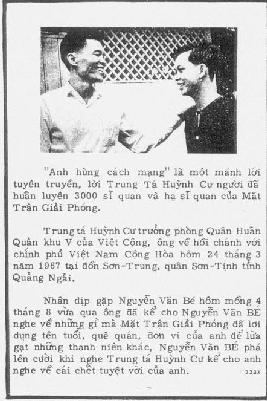 JUSPAO Leaflet # 2233
JUSPAO Leaflet # 2233
JUSPAO leaflet 2233, prepared in October 1967, is also about Nguyen Van Be. It is 5 x 7 inches in size. The front of the leaflet depicts Lieutenant Colonel (LTC) Huynh Cu meeting Nguyen Van Be. The text is:
Revolutionary heroism is a propaganda trick says LTC Huynh Cu, who trained 3000 National Liberation Front officers and noncommissioned officers. LTC Huynh Cu, former Chief of the Viet Cong Training Section, Military Region Five, who returned to the Government of the Republic of Vietnam on 24 March 1967 at Son-Trung camp, Son Tinh district, Quang Ngai province. Seeing Nguyen Van Be on 4 August, he related to him all the tricks of the Liberation Front of the South is using with his name, his home village and his unit to cheat the other young men. Nguyen Van Be burst out laughing when hearing LTC Huynh Cu tell him about his marvelous death.
The back of the leaflet depicts LTC Cu writing a letter:
As a military man who served with Communist cadres more than twenty years, I know well how they have to manipulate all of us to achieve their objectives. The only reality for them is that which will serve their interests. When I was training director for MR 5 I heard the story of Be's heroism. I doubted the story. However, I knew the importance of making men die for the cause so I kept quiet. After returning to the government I met Be and found that he had done nothing but let himself be captured. No heroics, no slogan shouting, no nothing. Now that the government has revealed this, the Communists must shout his heroism all the louder. Do you know why? Be is a victim, not a heroic soldier! The Communists are trying to make victims of us all. I feel it is my duty to save my comrades from emulating such false heroics.
JUSPAO also developed leaflet 2243 in October 1967. It is very similar to 2233. It is also 5 x 7 inches in size. It depicts the same photograph of LTC Cu and Nguyen Van Be as is shown in the earlier leaflet on the front. PSYOP records indicate that 5 million copies of this leaflet were printed and forwarded to Da Nang, Nha Trang, Pleiku, Bien Hoa and Can Tho. Text on the front is:Credible and verifiable facts whether favorable or not, are the backbonePsychological Operations Field Manual No.33-1" published in August 1979 by Department of the Army Headquarters in Washington DC.
of the leaflet message because they demand attention.
 JUSPAO Leaflet # 2243
JUSPAO Leaflet # 2243
Now that you are still living, you have created a big problem' LTC Huynh Cu tells dead martyr Nguyen Van Be. Here, LTC Huynh Cu, former Chief of the Viet Cong Training Section, Military Region Five, meets Nguyen Van Be who the communists claim is a dead hero. LTC Cu returned to the Government of the Republic of Vietnam on 24 March 1967 at Son-Trung Post, Son-Trinh district, Quang Ngai province. He met Nguyen Van Be in Saigon where they discussed the communist story of Be's heroic death while blowing up ARVN and American soldiers with a mine. Cu told Be at the time: Believe me, next time the Viet Cong will have to look for a death certificate when they want to honor somebody as a hero. Do you know why they persist in denying their mistake?
The back of the leaflet depicts LTC Cu writing a letter. Although the picture was probably taken the same time as the one used in 2233, the pose is slightly different. The text is:
Why must the communists lie about the living Nguyen Van Be? LTC Cu tells Nguyen Van Be at their meeting in Saigon on 4 August 1967: Having made a major hero out of you, the Viet Cong must now deny that you live. They must say that you are a bogus Be, a creature of fiction created by the Americans. They have built a major propaganda campaign on you and now that you are alive, the fact of your existence may destroy and refute an entire set of arguments.
The entire mental conditioning of NVA troops, pursued through political indoctrination sessions, the three-man cell system and constant exhortation by the cadre, aims at achieving automatic responses reflecting the communist party view of word issues. This rote learning becomes a powerful cohesive element. It can be chipped at only by repeated discoveries that what has been studied and accepted as gospel truth does not accord with visible facts in the soldier's personal experience.
JUSPAO PSYOP POLICY No. 59 -The NVA Soldier in South Vietnam as a Target dated 20 February 1968JUSPAO leaflet 2005 is a 5 x 8 inch leaflet developed in June 1967 that depicts Nguyen Van Be at home with his family. Eight people are pictured. The text is:JUSPAO Leaflet # 2005
Why is the Liberation Front afraid to let people speak the truth? Nguyen Van Be is alive, well, and shown here with his family. As anyone can see, Nguyen Van Be did not sacrifice himself. Why are you not permitted to speak the truth?
The back of the leaflet is all text:
To the people living in the area of Kim Son Village. Have courage. In your hearts, you know the truth, Nguyen Van Be lives. His family knows he lives. Everyone knows he lives. Yes, even the front cadre who forbid you to speak the truth. Even they know he is alive. You can see the truth in the eyes of the cadre. Why do you think the front must continue to say that Nguyen Van Be is dead? Have courage; nothing can change the truth in your heart.
JUSPAO also prepared a number of posters showing Nguyen Van Be. One is coded 1774, developed February 1967, and measures 17 x 22 inches in size. There are three photographs on the poster. One shows Be holding a newspaper featuring his picture (the same photo used on several leaflets), another shows Be in profile and the third shows a statue of Be. The text is:The key is always to tell the truth, and never promise something we cannot deliver. Once we have credibility, then we have an effective message that will win over propaganda and stories told by other factions. 310th PSYOP Company, Bamian, Afghanistan.JUSPAO Poster # 1774
HOW COULD SUCH A STRANGE THING HAPPEN? The 'late Hero' Nguyen Van Be reads about his own death. For many months, the communist newspapers in both North and South Vietnam have been telling everyone the fantastic story about the supreme sacrifice of the 'hero' Nguyen Van Be. Communist youth throughout Vietnam have been urged to emulate him. According to the communist story Be was captured on 30 May 1966 after fighting like a tiger to defend the arms and ammunition he was helping to transport along a canal near My An. Supposedly he was later forced to explain how a new mine worked, and seizing the opportunity he exploded it with his own hands against an armored vehicle. The communists claimed that be gladly gave his life for the cause and killed 69 Americans and ARVN troops. A heroic act indeed! This photograph of a statue built in honor of the 'late hero' was published on the front page of the Hanoi newspaper Van Nghe on 6 January 1967. It is supposed to show Be at the moment he sacrificed his life. However, read what Mr. Be has to say: 'We were convoying ammunition along a canal in the My An district. When I heard the Government of Vietnam shots, I plunged into the canal. I was captured after I jumped into the water. I never did any of the things they say I did. Why would the Front say such things?' Look at this: Here is the 'dead hero' alive and well. He is reading about his own death in the important Hanoi newspaper Tien Phong that carried the fantastic story on the front of the 7 December 1966 issue. Similar stories were broadcast over Radio Hanoi and Liberation Radio, and many poems and songs were written about the 'late hero' Nguyen Van Be.
Psychological Operations soldiers use persuasion to influence perceptions and encourage desired behavior. The cornerstone of PSYOP is truth, credibly presented to convince a given audience to cease resistance or take actions favorable to friendly forces.
U. S. Army Civil Affairs and Psychological Operations Command Missions and Functions.
JUSPAO Poster # 1983
A second poster depicting the same photograph of Nguyen Van Be holding a newspaper showing his picture was developed by JUSPAO in June 1967. The poster is 17 x 22 inches in size and printed in two colors. The code is 1983. The text is:
NGUYEN VAN BE IS STILL ALIVE!The man whom the Lao Dong Party of the North and the National Liberation Front of the South proclaim as a dead hero is in fact very much alive. However, the Front still insists that he is dead, and urges all youth to emulate his example. Yet, here is Nguyen Van Be holding the newspaper that describes him as the 'late hero' who sacrificed his life. Why does the Lao Dong Party and the National Liberation Front make up such a strange story? What do you think?
Besides leaflets, JUSPAO also produced a number of short radio and loudspeaker tapes that told the story of Nguyen Van Be. Tape number 113 was eight minutes long and entitled "Cousin of Nguyen Van Be." A synopsis of the text follows:
A tape statement by Nguyen Van Ba, former platoon leader, political officer, and cousin of Nguyen Van Be. In this message, Ba (a Hoi Chanh) reminisces about classes he conducted for the members of Nguyen Van Be's unit to inspire then to emulate Be. Upon learning that Be was alive he realized the hoax that had been perpetrated by the Viet Cong. He also compares living under Viet Cong control as opposed to Government of Vietnam control, and speaks of the Chieu Hoi program urging his former comrades to rally to the just cause.Tape number 114 is entitled "Friend of Nguyen Van Be." This is an 11-minute tape. A synopsis of the text follows:
A tape statement by Nguyen Van Tho, former National Liberation Front sabotage expert who knew Nguyen Van Be. This (a Hoi Chanh) reminisces about former hardships shared with his friends in the 322 x 12 unit. He recalls classes conducted on dead hero Nguyen Van Be and then states Be is alive and he has seen him with his own eyes. He also emphatically states that in a technical sense of the word it would have been impossible for Be to have exploded the mine against the armored personnel carrier as the National Liberation Front has described the event. He then requests that his friends meet him on the path to rally.
Tape number 115 is entitled "Squad leader from Nguyen Van Be's Company." This is a longer 11-minute tape. A synopsis of the text follows:
Tape statement by Le Van Hue, squad leader from the same transportation company as Nguyen Van Be. Hue states that he has rallied to the just national cause and is living a happy life. He compares his happy life with the hardships he suffered in the Viet Cong ranks. He also exposes the lies told by the National Liberation Front, which promised land and assistance to fighters in the Front. He discussed the Chieu Hoi program, and insures his former compatriots that if they rally they will receive good treatment. Hue assures his friends that Be is alive and well, that he has seen Be, that he had been captured and not killed, as stated by the Front. He urges his former comrades to rally to the just cause.Tape number 120 is only 35 seconds long. It is entitled "Nguyen Van Be." The text is:
Dear Fellow Citizens, I am Nguyen Van Be. I am the son of Mr. Nguyen Van Hue and Mrs. Le Thi Ba from Kim Son village, Long Binh district, Dinh Tuong province. I am a former member of Unit 860 x 16, a transportation unit in the central area of the South. On 30 May 1966, I was captured while on a mission on the Cai Beo canal, My Quy village, Kien Phong province. For some time the Front has proclaimed that I sacrificed my life by exploding a mine against an M-113 troop carrier, and have honored me with the title of 'dead hero' Nguyen Van Be. However, I want you all to know that the story is not true, because here I am, right now. I am still alive. I am alive and living here in the South. I ask you not to emulate my example of 'sacrifice.' I am telling you all about this so that you will know the truth.
Nguyen Van Be Invalid Veteran Pay Book?Robert Munshower discovered this Invalid Veteran pay book in the name of Nguyen Van Be while researching his history. I must state here that we are not sure this is the same individual, the name is not uncommon in Vietnam and this could be another young Viet Cong soldier with the same name as the revolutionary “hero.” Nguyen Van Be is an extremely popular name for Vietnamese males, especially those who are born in rural areas. However, his military record and time of injury match up fairly well with the Communist propaganda story of Be. Although we are not 100% positive that this is THE Nguyen Van Be, I believe we must depict portions of the book.
The Nguyen Van Be in this booklet was born November 1945 at Binh My Village, Hoc Mon District, Gia Dinh Province, and enlisted 14 February 1962. His rank when injured was Corporal (Deputy Squad leader) in unit C2D4E2F9. His was wounded in combat at Xa Cat, Binh Long. He spent 3 months and 3 days in a Viet Cong hospital, and was considered 35% disabled, Class 2, with a monthly stipend of 39 dong.
1971 reunion of Senior Viet Cong Defectors at Ben Tre, South VietnamNguyen Van Be is at the bottom right in white shirt and sunglasses.
Captain Bob Turner of the Joint United States Public Affairs Office
is above him in blue checkered shirt leaning against the wall.
Credibility is a condition of persuasion. Before you can make a man do what you say, you must make him believe what you say. A necessary condition for gaining his credence is that you do not permit him to catch you in lies. Hence, the constraint upon all propagandists to accurate reporting of matters which are subject to verification by the audience…Propaganda, to be effective, must be not only factually true, but credible.
This story of PSYOP intrigue is interesting because it seems to defy all the laws and logic of psychological operations. We have shown over and over again that the rules of PSYOP demand that (except in the cases of a disinformation campaign) the text of the propaganda message be truthful and credible. Yet, in the case of Nguyen Van Be the communists were shown to be liars. Repeatedly the Allied leaflets and posters pointed out that the communists had lied to the people. The result should have been a complete loss in credibility by the Vietnamese in communist propaganda. However, the old adage about the "big Lie" seems to have worked in the enemy's favor in this case.
…The magnitude of a lie always contains a certain factor of credibility, since the great masses of the people in the very bottom of their hearts tend to be corrupted rather than consciously and purposely evil, and that, therefore, in view of the primitive simplicity of their minds they more easily fall a victim to a big lie than to a little one, since they themselves lie in little things, but would be ashamed of lies that were too big.
Hanoi and the National Liberation Front controlled what their people heard and read. They spent several hours each day in the indoctrination of their troops. Every time the Allies pointed out the lie, the cadre counterattacked. They said that the GVN and the Americans were the liars, and that the fake Be was a figment of their imagination, an actor treated with plastic surgery who just pretended to be their dead hero. This would appear to be a case where the truth did not conquer. The big lie seems to have reigned supreme.
A lie told often enough becomes the truth.
What may be the most interesting aspect of this story is that experts who have traveled to Vietnam can not find a single street or building either in Hanoi, Saigon or any other major city named after the alleged hero, Nguyen Van Be. The communists honored all of their military heroes with streets and buildings named or renamed for them. It may be that even as they lied and propagandized their own people with tales of Be’s heroism, they secretly fumed at having been duped and waited for the first opportunity to erase him and make him a "non-person" in the best Communist tradition.
This article is just a brief look at the Nguyen Van Be campaign carried by JUSPAO against the North Vietnamese and Viet Cong. We have selected and depicted a few leaflets that were particularly interesting. If any of our readers have additional leaflets that they think should be included in this article, they are encouraged to send them to the author. You are invited to write to the author with comments or questions at Sgmbert@hotmail.com










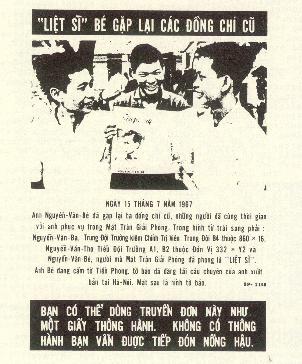
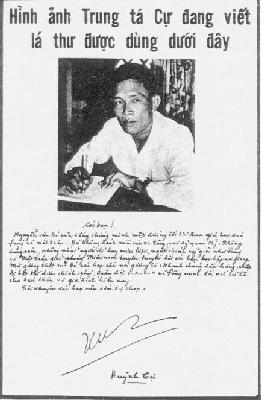




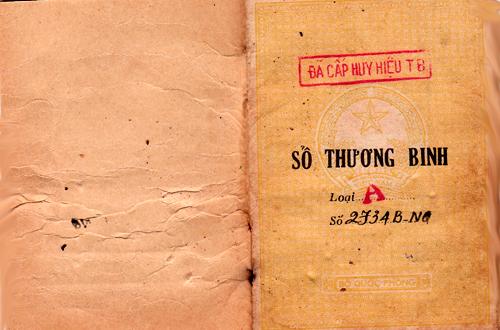

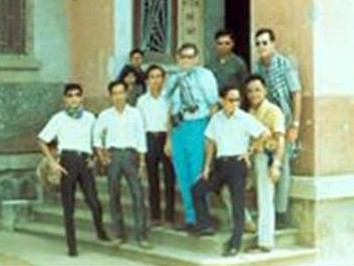

 - Thịt lợn xay, cua xay, thịt bò thái sẵn… được đông đảo người tiêu dùng chọn lựa bởi sự tiện dụng chúng mang lại. Tuy nhiên, thực tế là hầu hết các sản phẩm này đều không đảm bảo vệ sinh an toàn thực phẩm trong quá trình sơ chế.
- Thịt lợn xay, cua xay, thịt bò thái sẵn… được đông đảo người tiêu dùng chọn lựa bởi sự tiện dụng chúng mang lại. Tuy nhiên, thực tế là hầu hết các sản phẩm này đều không đảm bảo vệ sinh an toàn thực phẩm trong quá trình sơ chế.